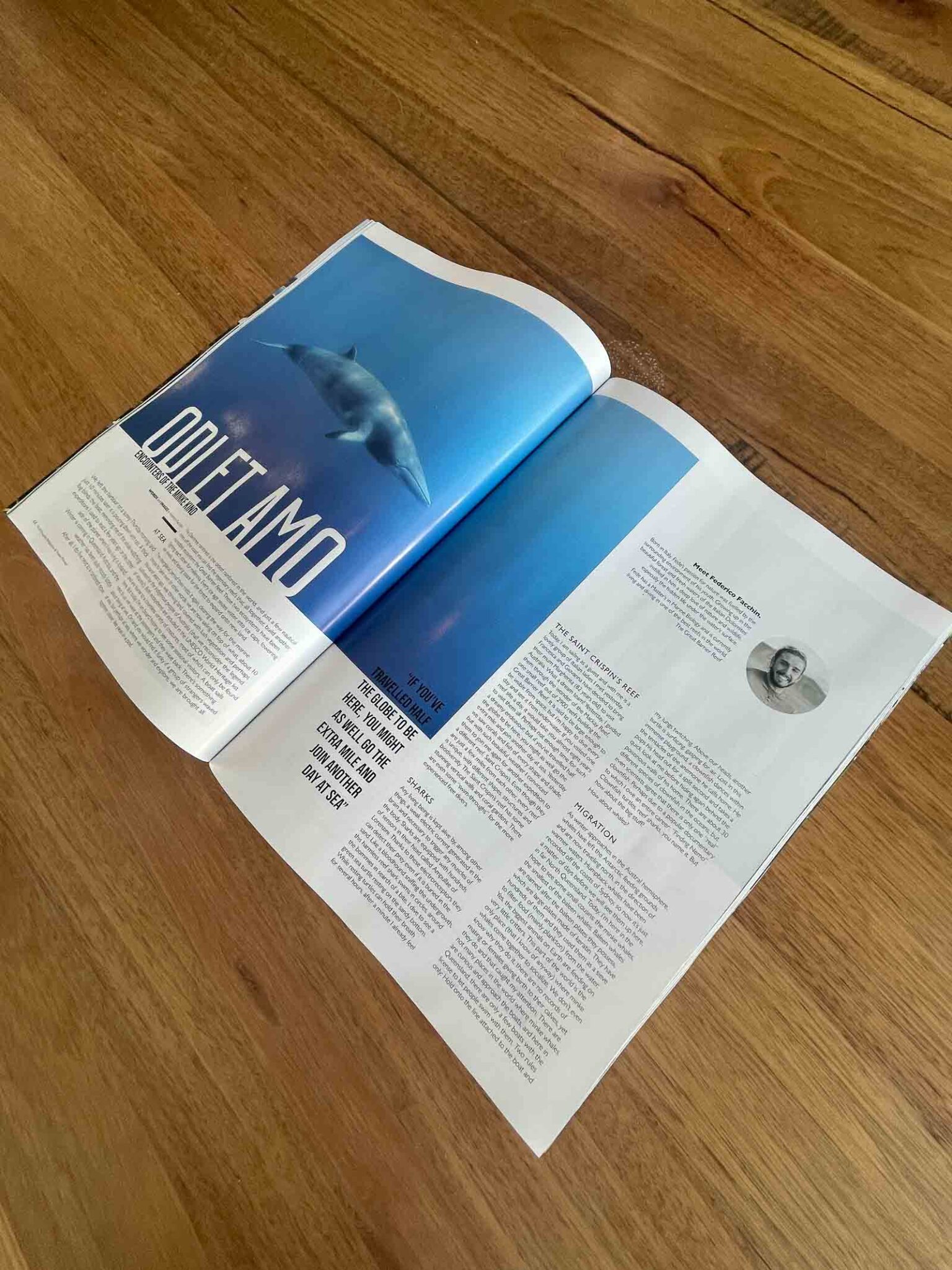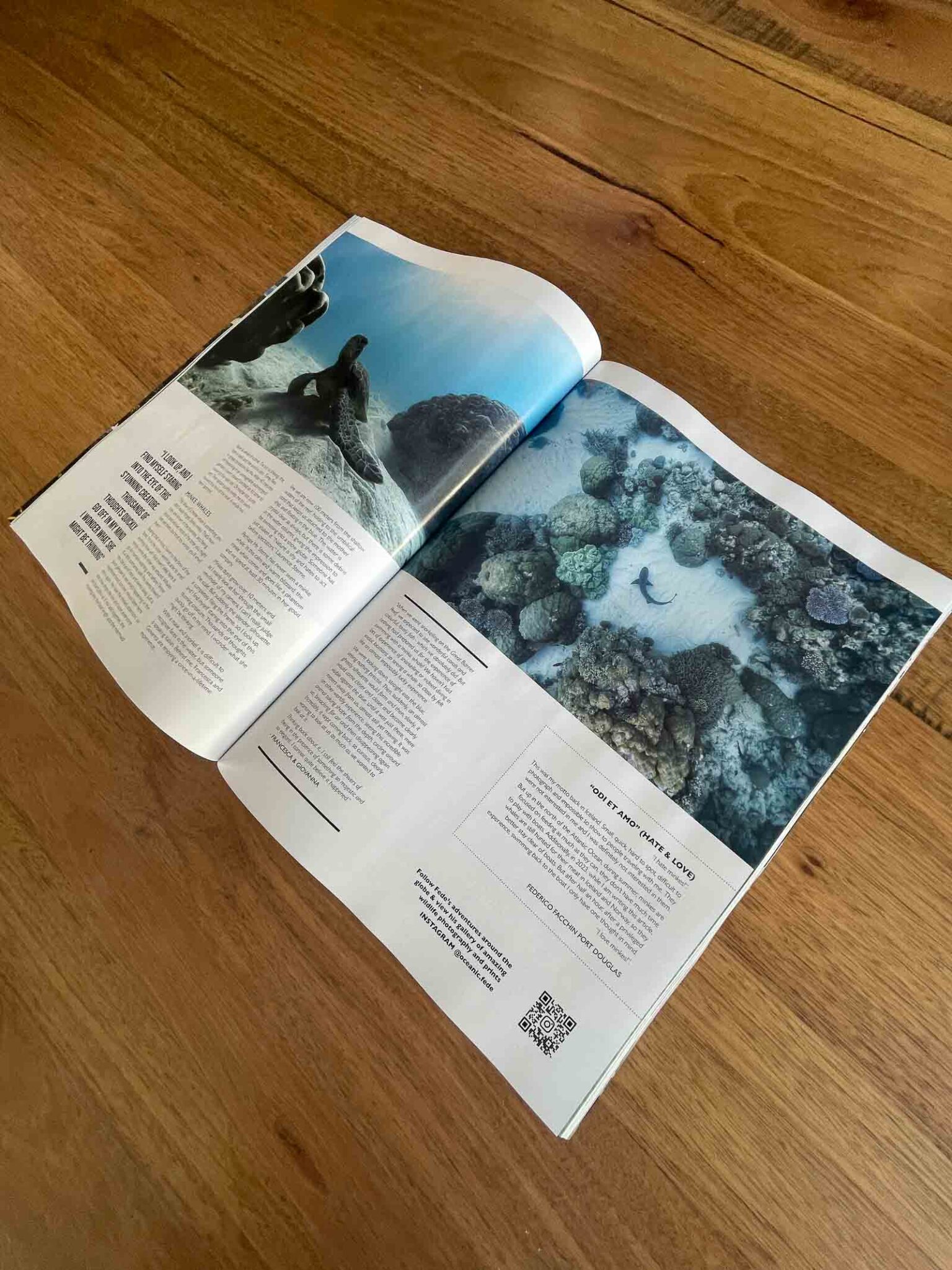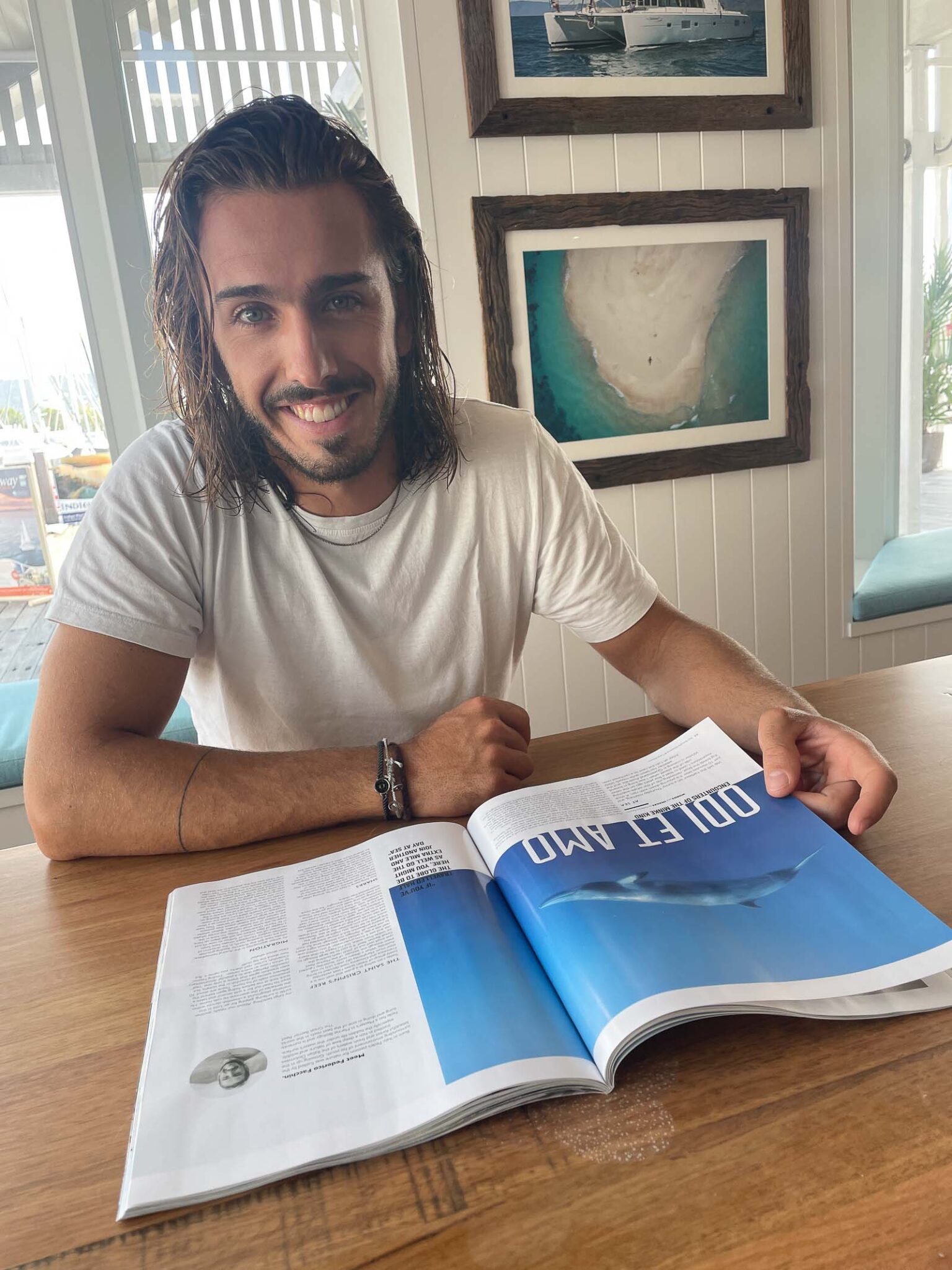Odi Et Amo
“After 40 minutes of freediving in an unimaginable submerged garden, I swim toward the boat as it’s time to move to the next site. Or maybe not quite yet? The captain quietly invites me to swim toward the bow of the boat. A whale has been spotted.”
AT SEA
We left the harbor on a sunny Thursday morning, and just 10 minutes later, it is pouring down with rain. A thick fog blinds the boat, reminding me of the whale-watching expeditions I used to lead a few years ago on the other side of the planet when I was living in Iceland. Winter is coming in Queensland Australia, and the weather has been quite moody lately. After all, I do live next to a rainforest now.
The Daintree rainforest is the oldest rainforest in the world, and just a few nautical miles off the coast you can find the legendary reefs, that all together, build another incredible ecosystem: the Great Barrier Reef. These two ecosystems have been fighting each other for millennia. Every ice age seizes water into ice caps, lowering sea levels, and leaving space for the forest to expand onto new land. The interglacial period then melts it again, clearing the way for the marine troops to take over. In other words, we are now sailing on top of what, about 10 thousand years ago, was thriving land, covered with lush vegetation and perhaps cultivated by the Indigenous people of Australia (shall we reconsider the legend of Atlantis?). Both ecosystems are included in the Unesco World Heritage list and are home to a countless variety of creatures, most of which can only be found here, but today I’m on board in the hope to see some seasonal visitors.
A boat sails next to us, we wave at the passengers and they wave back. There’s something about being at sea. On land you would find it funky if a group of strangers was to wave at you, but perhaps at sea, where we wonder and explore, we are brought all together, closer, like peas in a pod.
IMAGE LEFT: A Rainbow Lorikeet is unmistakable with its bright red beak and colorful plumage.
© Federico Facchin – 2023 – Australia
IMAGE RIGHT: Freshwater fish living in the Daintree rainforest.
© Federico Facchin – 2023 – Australia
The Saint Crispin Reef
Today, I am sailing as a guest and with me is a lovely group of Italian ladies I met yesterday.
Francesca and Giovanna have decided to bring their mum Margherita (82 years old) to visit Australia. What a dream team! Yesterday, I guided them through the wonder of the Makay Reef, one small reef out of 2900 reefs building the Great Barrier Reef. It is said to be large enough to be visible from space, but I’m happy to dive every day and see it from underwater. If you were to visit one reef site a day, it would take you almost 8 years to visit them all. Perhaps not enough time for such a dreamy endeavor, but if you’ve traveled half the globe to be here, you might as well go the extra mile and join another day at sea. Yesterday we saw corals and fish of every shape and shade, but with such beautiful weather I convinced them to join me again for another expedition to a different reef, the Saint Crispins reef. Even though they are just a few miles from one another, every reef is unique, with different shapes, structures and biodiversity. The Saint Crispins reef has some stunning vertical walls and coral gardens. There are even some “swim-throughs” for the more experienced free divers.
IMAGES ABOVE: Colorful coral gardens.
© Federico Facchin – 2023 – Australia
A whitetip reef shark seems to be very active.
Any living being is kept alive by, among other things, a weak electric current generated in the brain and necessary to trigger any muscles of the body. Sharks are equipped with hundreds of sensors in their head called Ampullae of Lorenzini. Thanks to these electroreceptors they can detect their prey even if it is buried in the sand. Like a Bloodhound sniffing the undergrowth, this harmless reef shark swims in circles, around the bommies in search of a bite.
I dive to see a green sea turtle resting on the sandy bottom. While resting turtles can hold their breath for several hours, but after a minute I already feel my lungs twitching. Above our heads, another turtle is surfacing, gasping for air.
IMAGES ABOVE: A small reef shark swims between the corals looking for a prey. Green turtles can hold their breath for several hours and even sleep underwater.
© Federico Facchin – 2023 – Australia
Lost in this immense playground, a clownfish dances within the tentacles of the anemone he calls home. He pops his head out for a split second and takes a quick look at me before hiding again behind the poisonous walls of his home. There are about 30 different species of clownfish in the oceans, but even scientists agree that there is only one “real” clownfish. Perhaps due to a popular documentary to which I owe an entire career: “Finding Nemo”.
Clownfish, turtles, reef sharks, you name it. But how about the big stuff?
How about whales?
IMAGES ABOVE: A colorful clownfish finds shelter in his anemone.
© Federico Facchin – 2023 – Australia
Migration
As winter is approaching in the Austral hemisphere, whales have left the Antarctic feeding grounds and are now traveling north, in the direction of warmer waters. Humpback whales have been recorded about a month ago off the coasts of Sydney, so it’s just a matter of days before we will see them up here, in far North Queensland.
Today, I’m here in the hope to see some small cousins: the Minke whales, the smallest of the Baleen whales. Baleen whales are named after the Baleen plates they possess, which are large plates made of keratin. They have hundreds of them and they used them as a sieve to filter food (mainly plankton) from the water. Yes, the biggest animals on Earth are feeding on very little critters. This part of the world is the only place (that I know of anyways) where Minke whales come together to socialize. We don’t even know why they do it, there are no records of matings or females giving birth to their calves, yet they do and that caught my attention. There are not many places in the world where Minke whales are curious and approach the boats, and here in Queensland, there are only a few boats with the license to let people swim with them. Two rules only: hold onto the line attached to the boat, and have a whale of a time.
The sun is shining, the tide is slack and the wind is calm. Time flies in great conditions like this. After 40 minutes of freediving in an unimaginable submerged garden, I swim toward the boat as it’s time to move to the next site. Or maybe not quite yet? The captain quietly invites me to swim toward the bow of the boat.
A whale has been spotted.
IMAGE ABOVE: A Humpback whale lunge feeding in the arctic waters.
© Federico Facchin – 2022 – Norway
Minke whales
The blow of a minke whale is something you don’t easily forget. Stinky minky. That’s how they are known in the business, and being quick and elusive, most of the time you might not see them, but trust my words: you’ll smell them!
Bearing that in mind, I swim to the bow of the boat. I’m in the water, I won’t be able to smell anything, how will I find them? Well, here it simply works the other way around. Whales go for humans watching, and before I know it, a little submarine with fins swims toward me, has a good look and swims away. Just a quick glimpse to see what’s happening in the neighborhood, but one minute later here she is again. We have the Minke’s attention so the crew drops the line and soon everyone on board joins us.
IMAGE ABOVE: The Minke whale swimming in the crystal clear waters of the Great Barrier Reef.
© Federico Facchin – 2023 – Australia
If you add together, the mooring line, the boat length and the mermaid line we are now 100 meters from the shallow waters of the reef, holding to the umbilical cord that keeps us attached to the mother ship, and floating in the blue. The water is crystal clear as always, but there is some debris in the water column, giving the impression to be swimming into a snow globe. Someone has just shaken it.
IMAGES ABOVE: Adults tend to reach a length of between 7 and 10 meters and can live for up to 50 years.
© Federico Facchin – 2023 – Australia
“Nature is shy and hates to act before spectators“ Laurence Sterne.
Perhaps Mr. Sterne has never seen a minke whale. In this calm and warm blizzard, the minke whale comes and goes like a phantom and we spend at least 30 minutes in her good company.
Minkes don’t grow over 10 meters and as I mainly look at her through the small viewfinder of my camera I can’t really judge the scale. But all of a sudden, the slender silhouette is filling completely the frame so I look up, and I find myself staring into the eye of this stunning creature. Thousands of thoughts quickly go off in my mind. I wonder what she might be thinking.
With a mask and snorkel it is difficult to recognize faces in the water but someone is speaking Italian. Behind me, Francesca and Giovanna are enjoying a once-in-a-lifetime experience.
“When we went snorkeling on the Great Barrier Reef we expected to see wonderful corals and colorful, lovely fish – which we absolutely did. But nothing had prepared us for the experience of swimming with a minke whale! We haven’t had lots of experience of snorkelling or indeed diving in exotic locations so seeing a whale so close by felt like an almost impossibly lucky experience. We were looking down, straight into the blue, seeing nothing precise. Then, all of a sudden, an almost ghostly silhouette would form and then, slowly, it would come closer and closer and become clearly visible against the blue, until it was just there, mere meters away from us, almost still yet moving. It was an other-worldly experience, seeing this incredible animal taking shape from the depth, circling around us, breaching for air and then disappearing again. Incredibly, it kept coming back. so curious, clearly wanting to look at us as much as we wanted to look at it. Thinking back about it, I still feel the shivers of being in the presence of something so majestic and so elegant. I cannot quite believe it happened.”
Francesca & Giovanna
"Odi et amo" (hate & love)
“I hate Minkes!”.
This was my motto back in Iceland. Small, quick, hard to spot, difficult to photograph and impossible to show to people traveling with me. They were not interested in me and I was definitely not interested in them.
But up in the north of the Atlantic Ocean, during summer, Minkes are focused on feeding as much as they can, they don’t have much time to play with boats. Additionally, in 2023, while I am writing this article, whales are still hunted for their meat in Iceland and Norway, so they better stay clear of boats. But after half an hour, after a privileged experience, swimming back to the boat I only have one thought in mind.
“I love Minkes!”.
Federico Facchin
Port Douglas – QLD
15-06-2023
IMAGES ABOVE: “Minke Dreams”.
© Federico Facchin – 2023 – Australia
Fine Art Collection
"Oceans"
Would you like a piece of art that brings nature back into your house? Tired of the urban environment of your city? Or do you simply love the outdoors and your heart is longing for the next adventure?
Decorate your wall space with the Oceans collection, now available in a limited edition.
This limited edition print comes signed, numbered, with a certificate of authentication, and always with Passepartout.
Published in Port Douglas Magazine
SHARE
Newsletter
Join our newsletter family for exciting content, special promotions, and behind-the-scenes stories. Subscribe now, and who knows, you might receive an email from me once in a blue moon (if you’re lucky). I plan to send monthly emails, but I’m a bit out of touch with reality. Rest assured, when I do send one, it’s bound to be something special.
Catch you on the flip side!
(Double-check spam folder after subscription)





